José Díaz-Balart gets virtual recreations of NYC studios for MSNBC show, Saturday ‘Nightly’
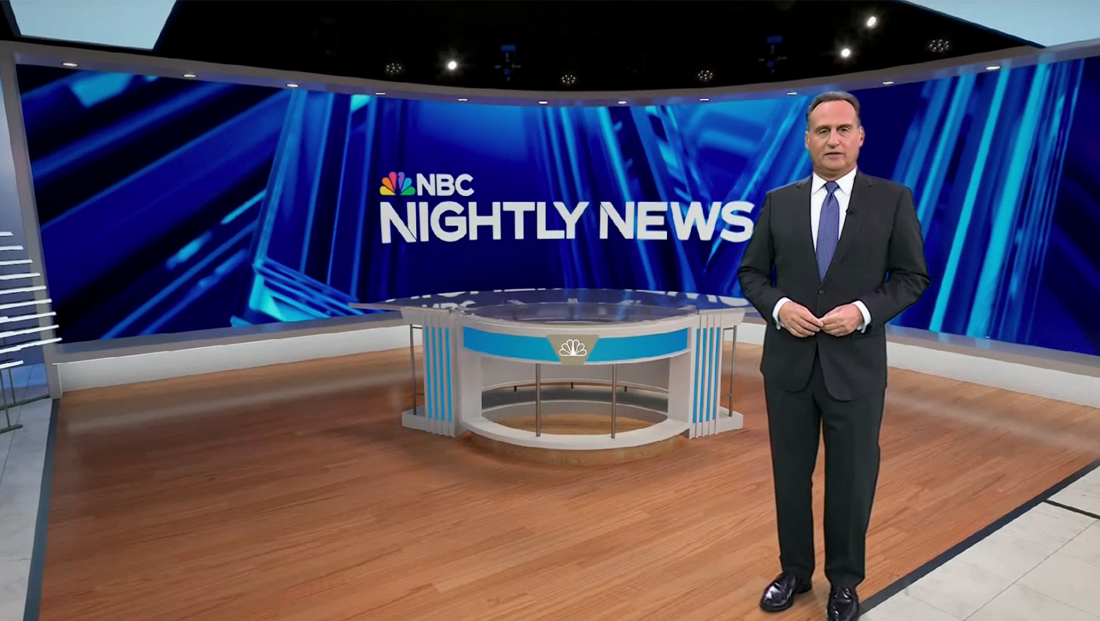
Subscribe to NCS for the latest news, project case studies and product announcements in broadcast technology, creative design and engineering delivered to your inbox.
NBC News‘ José Díaz-Balart has transitioned to virtual recreations of studios in New York City while originating from Telemundo’s headquarters near Miami.
The virtual sets debuted July 17, 2023, on MSNBC’s “José Díaz-Balart Reports” with a separate model on July 22, 2023’s “NBC Nightly News.”
Both virtual sets lend some additional consistency to the on-air look of both broadcasts and also add the ability for it to appear that Díaz-Balart is standing on the actual floor of the studio thanks to wide, full body shots that attempt to account for how a floor would interplay with the camera angles.
‘José Díaz-Balart Reports’
Díaz-Balart’s edition of “MSNBC Reports” now originates from a 3D recreation of MSNBC’s Studio 3A in New York, mirroring the studio’s marble and gold accents.
For “Reports,” NBC recreated at least two key areas of the studio, including the two large LED video walls that meet at a 90-degree angle as well as the neighboring venue that combines an LED video column that segues into a ceiling element and the floor-to-ceiling video wall with the so-called “Kornacki Curve” ribbon segment.
In New York, the corner LED array typically displays a virtual set extension that was first used in the fall of 2021. These draw on a 3D environment that combines multiple curved, somewhat fantastical structural elements with nods to real sets, such as the former “NBC Nightly News” set on the west side of Studio 3A, mixed in.
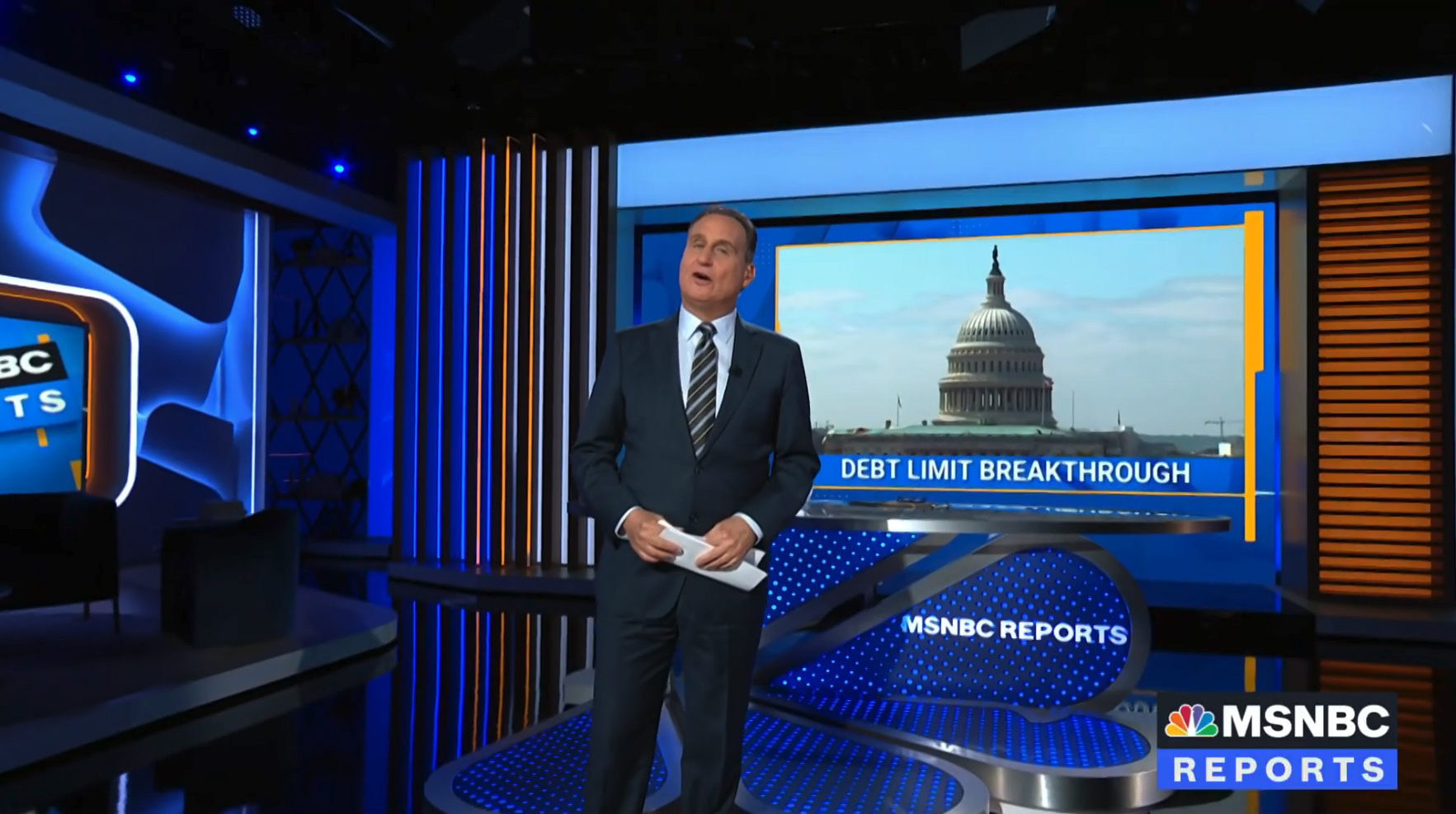
In Miami, Díaz-Balart can present from both seated and standing positions, including using an NBC peacock-themed anchor desk with a feather base and glass top. This desk had been used from when “Reports” originated from the primary “Noticias Telemundo” set and, later, the flexible modular space used for both “La Mesa Caliente” and “The Katie Phang Show.”
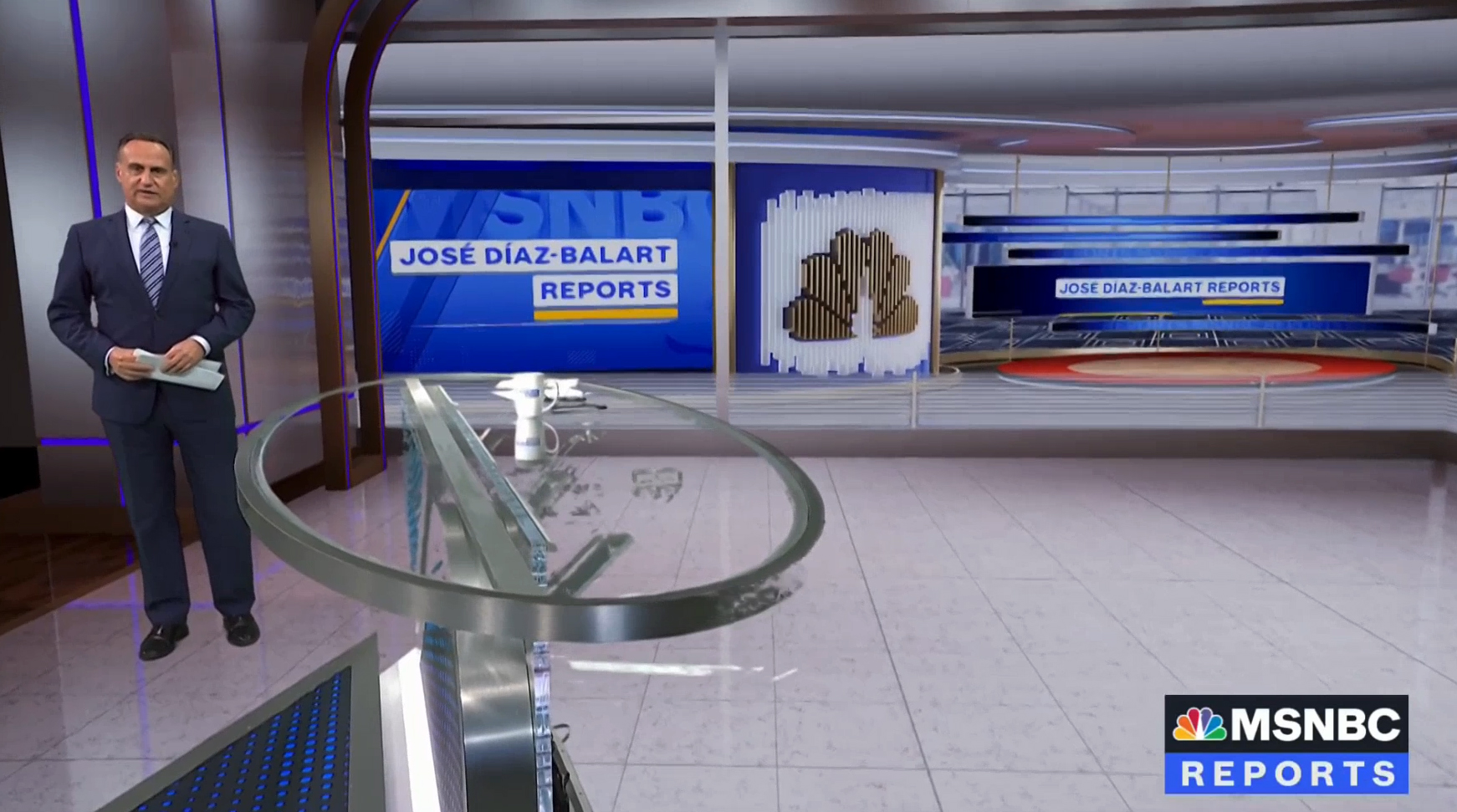
There’s a glitch in the matrix: Note how the anchor desk to the right of the presenter in this image has portions that disappear oddly.
The broadcast is also able to incorporate on-camera moves and angles that interact with the virtual environment in real-time, as opposed to a more traditional chroma key background. These tend to be restricted more to simplified push-ins and adjustments as opposed to the more free-wielding handheld camera shots frequently used back in New York.
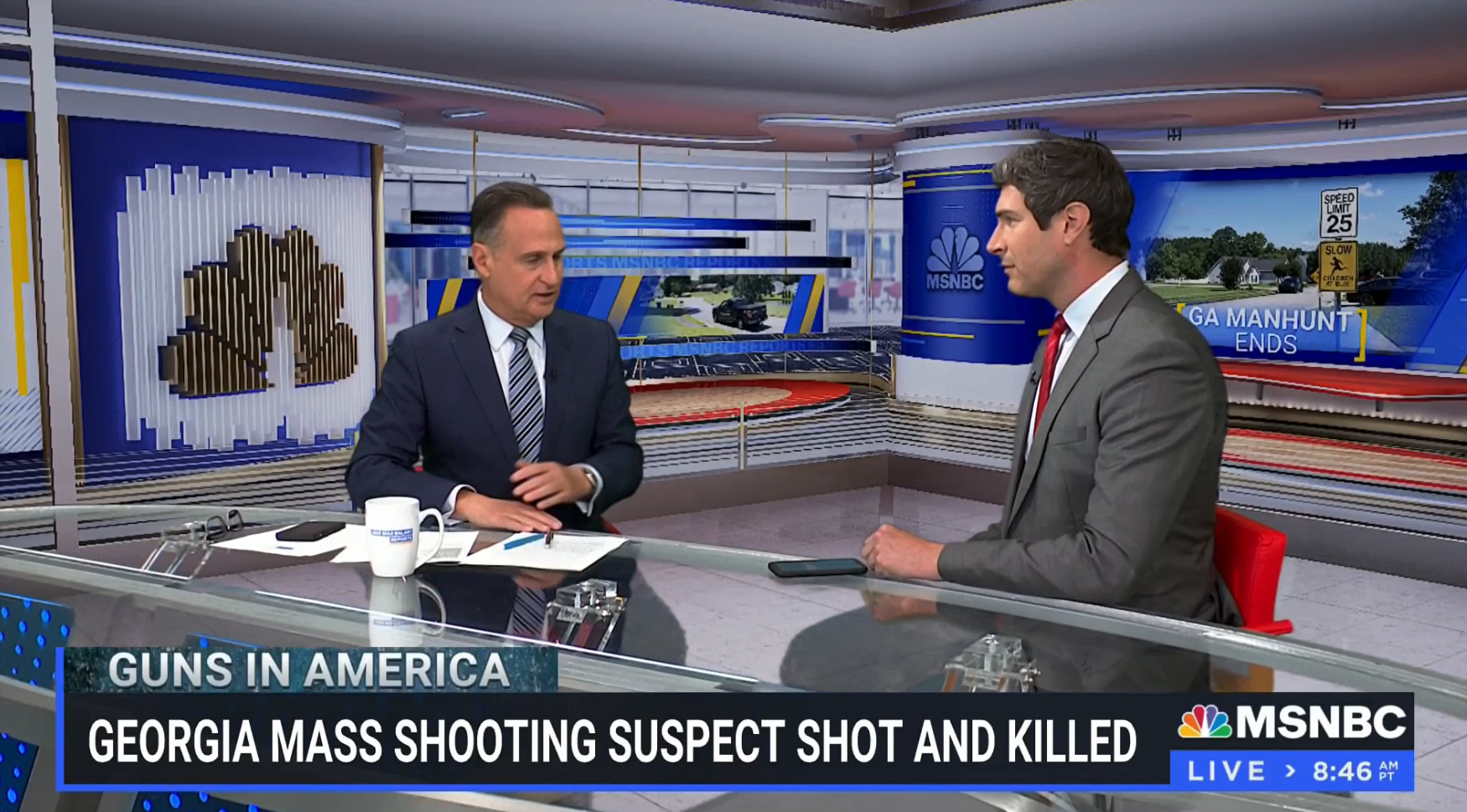
This includes bringing guests into the studio and shooting the setup with a combination of wide two-shots and one-shots on both the anchor and guest.
MSNBC also continues the practice of inserting topical graphics into various places in the virtual set extension backgrounds, including on the faux curved LED ribbon array camera left and curved wall-like structure to the right. These designs continue to draw on the blue, white and yellow look that also debuted in 2021.
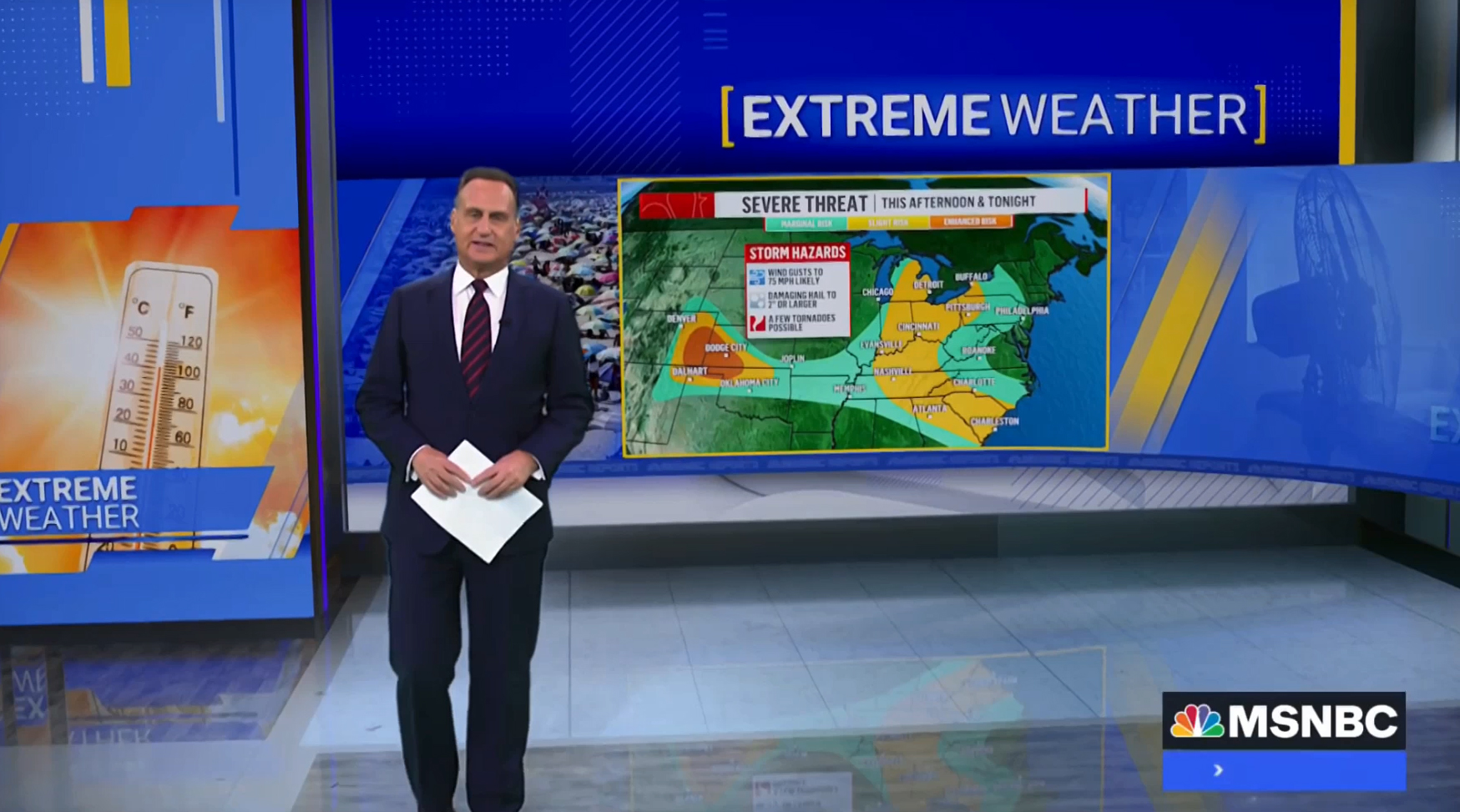
Despite appearances, José Díaz-Balart is not in New York in this shot.
An alternate portion of the virtual set includes the part of 3A boasting the wraparound video ribbon element and the curved ribbon with flat video wall behind it.
Like the other recreation segments, the network can insert topical graphics across numerous parts of the simulated set and the software accounts for reflections on the shiny floor.
During a weather segment later in the week of July 17, the camera even moved in on the weather map being shown behind Díaz-Balart using the floating camera “walk and wander” and “video on video” technique that’s become popular across both MSNBC and TV news in general.
There was even an added element of realism as the camera shifted to that part of the video wall — the map became slightly out of focus to viewers. It’s not clear if this was due to an issue with the camera or virtual set implementation. While on-set video walls are not always the clearest when captured on camera, most broadcasters still attempt to keep the text and imagery on them as clear as possible and this map example bordered on being illegible.
‘NBC Nightly News’
Meanwhile, NBC opted to use the setup with a different virtual set to recreate Studio 1A in New York.
“Nightly” moved to the space in September 2021 and takes advantage of its large, 40-foot video wall as well as various smaller arrays installed throughout the space.
Díaz-Balart can be shown standing in front of the largest video wall, with the anchor desk placed behind him, as branded and topical graphics are displayed on the virtual video wall behind him. Here to, the camera does have an on-air move, though, again, it’s not quite as dynamic or organic as the shots used in New York.
Díaz-Balart can also be shown in front of the dual video walls installed camera left of the primary area, which are used for the bulk of his reads.
Here again, the background combines a virtual recreation of the structural elements while also inserting graphics that reflect the day’s news as needed. These shots notably do not include the on-camera jib-style moves used with weekday anchor Lester Holt in New York, though on-camera moves are still possible.
This implementation is notably distinct from what NBC had been doing behind Díaz-Balart’s Saturday editions of “Nightly,” though both techniques did attempt to create the illusion he was in New York.
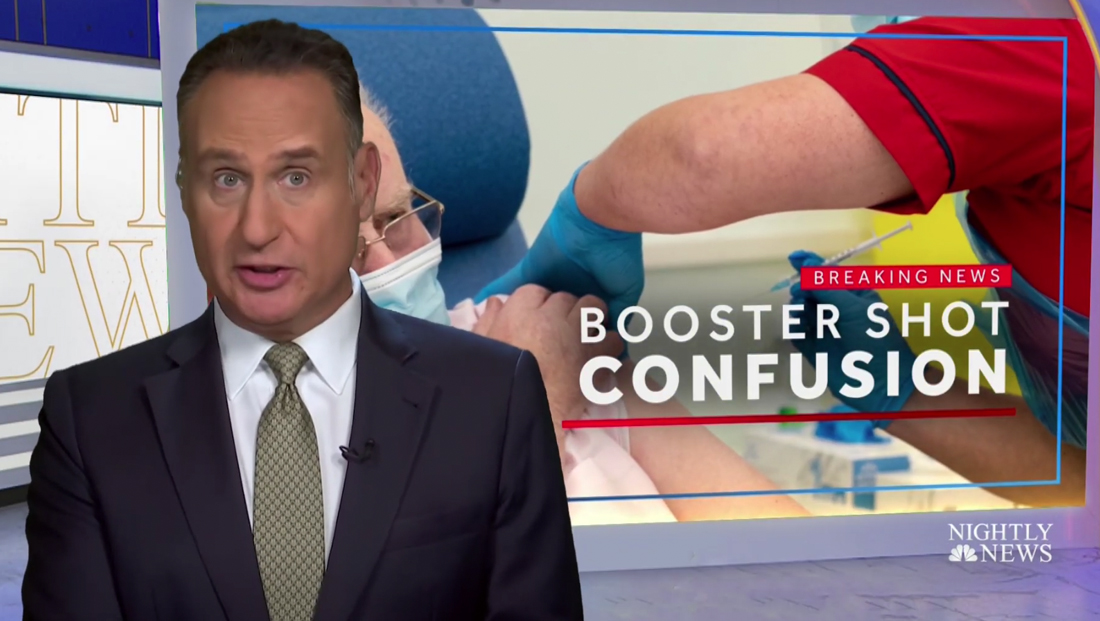
A September 2021 screenshot from ‘NBC Nightly News’ from Miami prior to the broadcast getting a new logo and graphics.
For a period, Díaz-Balart had been appearing in front of what was essentially a composited image of 1A that was being fed to a video panel sitting behind him. This setup is known within NBC as a “news nook,” though it is more appropriately known as an insert studio.
These setups typically include a single camera, often robotic, with a place for talent to sit in front of a video screen that can be used to showcase graphics or live camera feeds, creating the illusion the person is sitting in front of a window, printed graphic or, in more recent applications, a portion of a real set. In some cases, insert studios also use chroma key backgrounds to insert backdrops.
When images of a real set are used in this type of setup, it’s not technically what most would consider a full virtual set — since, for example, there is limited ability for talent to interact with the backdrop. When a physical monitor is used, there can also be a limited ability for the camera to push in or out or make framing adjustments live on air (though this depends largely on the size of the screen and position of camera).
When the camera pans, tilts or zooms on talent sitting in front of a monitor, the image of the monitor remains in a fixed X-Y coordinate behind the person since it’s not being keyed in. On-camera moves in front of chroma key are typically more limited because they create a strange effect of the key image remaining the same perspective and scale while the person moves around.
Before the implementation of the virtual set in Miami, “Nightly” was able to replicate, in a more limited manner, the feel of Díaz-Balart being in New York. The new application is notable for its wider framing and the addition of camera tracking. It also allows for shooting full-body shots of Díaz-Balart standing, ostensibly in front of a large video wall.
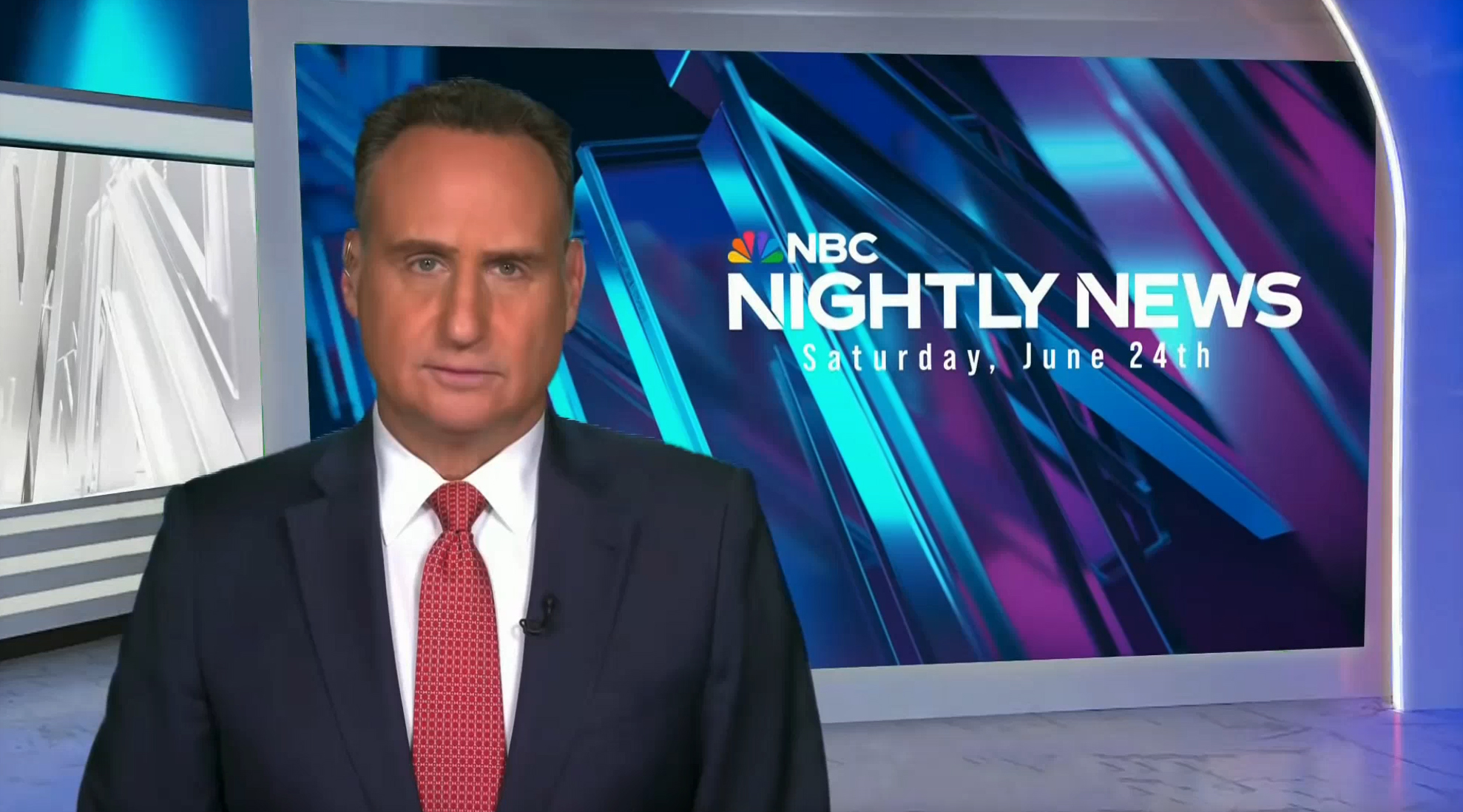
This June 24, 2023 image appears to be using the virtual set technology instead of an insert studio-style setup. Note the change in lighting from the image immediately above this one as well as the slight glow on the anchor and slight jagged edges around his shoulders.
Prior to July 17, Saturday “Nightly” editions featuring Díaz-Balart began to take on a slightly different feel with how he was lit. Small imperfections around his shoulders began to appear — and a slight, almost imperceptible colored glow appeared around him. In hindsight, it appears likely that NBC was testing out the new virtual set look in simplified ways ahead of rolling out the broader use.
So far, “Nightly” has not attempted to recreate the “video on video” floating camera “walk and wander” shots that typically accompany the top story each evening as the anchor reads copy.
The July 17 edition of the broadcast did include a similar voiceover from Díaz-Balart as graphics, imagery and maps were shown fullscreen, but the network did not attempt to simulate these as if they appeared on the actual set.
From a technical standpoint, this is understandable. These shots typically use much more complex camera moves and have to be timed tightly, so it may not have been possible to recreate these looks reliably.
In theory, these could have been created either by piping in live or pre-taped shots from the real 1A over Díaz-Balart’s voiceover, though this would have required coordinating between two locations and having a crew to staff both studios, something that might not be logistically advisable, especially on weekends.
The network could have also grabbed imagery of the set in New York, imported them into project templates with frames for dynamic topical imagery to be inserted onto the spaces occupied by real LED and then either played them back in real time or as pre-recorded video clips.
Why Miami?
Díaz-Balart became anchor of Saturday editions of “Nightly” in 2016. He sometimes traveled to New York to anchor the program, though that practice was slowly eliminated. The COVID-19 pandemic essentially put a complete end to that travel, though it still could happen to this day if, for example, Díaz-Balart needed to be in New York for another reason.
This meant that Díaz-Balart, who anchored for Telemundo, which is based outside Miami, would largely remain stationed in Florida and it essentially became the permanent practice for him to anchor both his MSNBC and “Nightly” from the state.
For a period, the insert studio solution was used to create some visual consistency between New York and Miami broadcasts, though they were much more limited than a full virtual set. It appears that NBC is doubling down on ensuring that Díaz-Balart can remain stationed in Miami for most broadcasts.
A different kind of virtual set
Although the setups being used for “Reports” and “Nightly” in Miami would largely be considered virtual sets by most, there is a slight distinction.
Both virtual sets are based on an actual set and use textures and imagery of those real sets, as opposed to being a fictitious 3D environment created in a rendering program like many virtual sets lean heavily on.
That’s not to say that imagery of real environments has never been used in a virtual set.
The background appears to combine still photos of studios in New York with a combination of 3D mapping and full 3D elements.
This approach actually helps add to the realism of the virtual set. For example, the images captured of the real spaces include slight imperfections in the flooring material. There are also visible tape marks in some views.
While these could be considered “imperfections,” they also help bring the slight variations that occur in materials on real sets that make the look more believable.
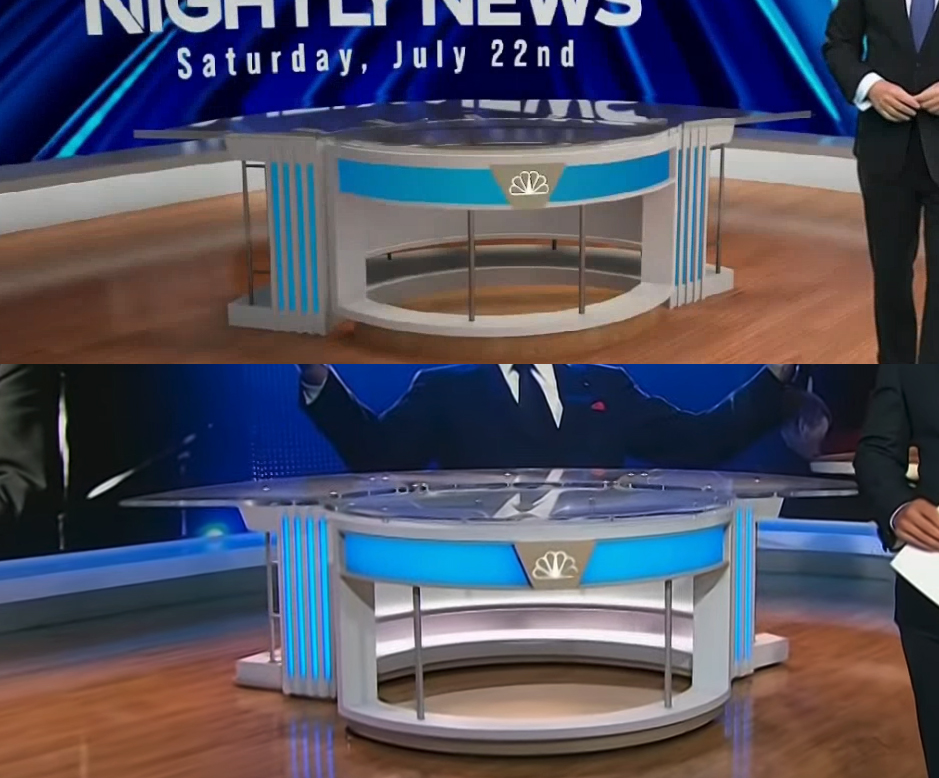
In this composite created by NewscastStudio, enlarged screen shots of the Miami virtual version of the Studio 1A set, top, and real life version, bottom, are shown. There are clear differences between the structure, depth and texture between the real and faux one; there is also a distinct lack of reflections from the desk in the virtual version.
One notable oddity, however, is the empty anchor desk that NBC typically places in front of the large video wall in Studio 1A. In New York, as shown in the detail of the screen grab in the lower part of the image above, the desk has all the shadowing and lighting variations that one would expect of an actual, physical piece of scenery sitting on a real floor.
However, as the screenshot above that shows, the desk is much simpler when it appears behind Díaz-Balart. Shadows are not nearly as detailed and the backlit blue segments are almost entirely the same shade as opposed to the varying intensities in the real thing. There are also obvious differences in the placement of the metallic piping on the front of the desk; as well as glaring differences between the materials and lighting of the base of the unit.
Because of this, the virtual version is likely based nearly entirely or completely on a 3D model of the desk. Why? Likely to because it was too difficult to get the reflections from the virtual video wall to interact properly with the “glass” top of the desk in the virtual iteration.
Did it work?
While the virtual sets used on both the MSNBC and NBC broadcasts do help establish a consistent look with the other editions of the broadcasts, the look does ultimately still suffer from parts that don’t feel quite right.
Using a recreated real spaces does go a long way in helping create a more realistic feeling.
The MSNBC version is also aided significantly by the fact it relies heavily on virtual set extensions that appear to have been designed to straddle the space between the real and unrealistic.
Similarly, “Nightly” benefits from having a good portion of the backgrounds being graphics instead of real scenic elements.
That said, there are still those slight issues — such as that “too perfect” anchor desk — that tug, almost at an unconscious level, that something doesn’t quite match up.
Subscribe to NCS for the latest news, project case studies and product announcements in broadcast technology, creative design and engineering delivered to your inbox.






tags
José Díaz-Balart Reports, MSNBC, NBC News, NBC Nightly News, Studio 1A Rockefeller Center, Studio 3A, telemundo, Video Walls, Virtual Sets
categories
Augmented Reality, Virtual Production and Virtual Sets, Heroes, Virtual Sets